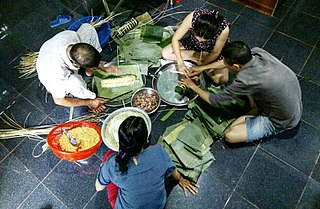
Tết, short for Tết Nguyên Đán, is the most important celebration in Vietnamese culture. Tết celebrates the arrival of spring based on the Vietnamese calendar and usually has the date in January or February in the Gregorian calendar.
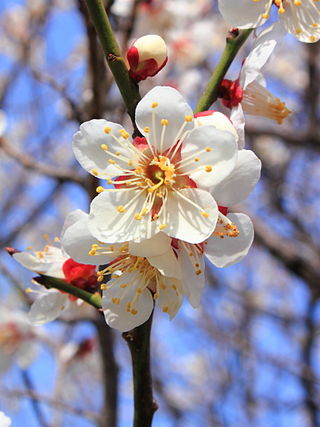
Prunus mume is a Chinese tree species classified in the Armeniaca section of the genus Prunus subgenus Prunus. Its common names include Chinese plum,Japanese plum, and Japanese apricot. The flower, long a beloved subject in the traditional painting and poetry of Sinospheric countries, is usually called plum blossom. This distinct tree species is related to both the plum and apricot trees. Although generally referred to as a plum in English, it is more closely related to the apricot. In East Asian cuisine, the fruit of the tree is used in juices, as a flavouring for alcohol, as a pickle, and in sauces. It is also used in traditional medicine.
Articles related to Vietnam and Vietnamese culture include:
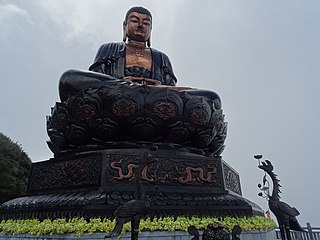
Buddhism in Vietnam, as practiced by the Vietnamese people, is a form of East Asian Mahayana Buddhism. It is the main religion in Vietnam. Vietnamese Buddhism is generally inclusive and syncretic, drawing on the main Chinese Buddhist traditions, such as Tiantai and Huayan, Zen (Thiền), and Pure Land.

Trà VinhCity is the capital city of Trà Vinh province in Southern Vietnam.
Vietnamese literature is the literature, both oral and written, created largely by the Vietnamese. Early Vietnamese literature has been greatly influenced by Chinese literature. As Literary Chinese was the formal written language for government documents, a majority of literary works were composed in Hán văn or as văn ngôn. From the 10th century, a minority of literary works were composed in chữ Nôm, the former writing system for the Vietnamese language. The Nôm script better represented Vietnamese literature as it led to the creation of different poetic forms like Lục bát and Song thất lục bát. It also allowed for Vietnamese reduplication to be used in Vietnamese poetry.

In art and iconography, a motif is an element of an image. Motifs can occur both in figurative and narrative art, and in ornament and geometrical art. A motif may be repeated in a pattern or design, often many times, or may just occur once in a work.

Kanō Sansetsu was a Japanese painter also known as Kanō Heishiro. He was born in Hizen Province, Kyūshū, and died in Kyoto.

Ven. Thich Nhat Tu or Thích Nhật Từ (釋日慈) in Vietnamese is a Vietnamese Buddhist reformer, an author, a poet, a psychological consultant, and an active social activist in Vietnam. He is committed to propagate Buddha's teachings through education, cultural activities and charitable programs in order to benefit the individuals and the society at large.

The national flower of the Republic of China was officially designated as the plum blossom by the Executive Yuan of the Republic of China on 21 July 1964. The plum blossom, known as the meihua, is a symbol for resilience and perseverance in the face of adversity, because plum blossoms often bloom most vibrantly even amidst the harsh winter snow. As the plum tree can usually grow for a long time, ancient trees are found throughout China. Huangmei county in Hubei features a 1,600-year-old plum tree from the Jin Dynasty which is still flowering. The three stamens represents Dr. Sun Yat-sen's Three Principles of the People, while the five petals symbolize the five branches of the government: Executive Yuan, Legislative Yuan, Judicial Yuan, Examination Yuan and Control Yuan. The flower has also been proposed to be one of the national flowers for the People's Republic of China.
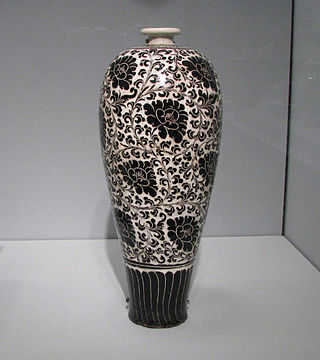
A meiping is a type of vase in Chinese ceramics. It is traditionally used to display branches of plum blossoms. The meiping was first made of stoneware during the Tang dynasty (618–907). It was originally used as a wine vessel, but since the Song dynasty (960–1279) it also became popular as a plum vase and got its name "meiping". It is tall, with a narrow base spreading gracefully into a wide body, followed by a sharply-rounded shoulder, a short and narrow neck, and a small opening.
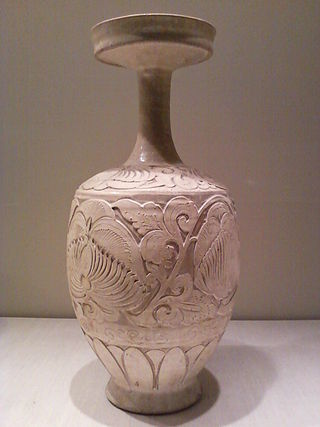
Vase with carved peony scrolls is a Cizhou-type stoneware vase of the Northern Song dynasty, made about 1100 and now in the Asian collection of the Indianapolis Museum of Art, where it is currently on display in the Richard M. Fairbanks Gallery.
The Story of Phạm Tải and Ngọc Hoa is an anonymous 18th Century Vietnamese language epic poem of 934 verses.
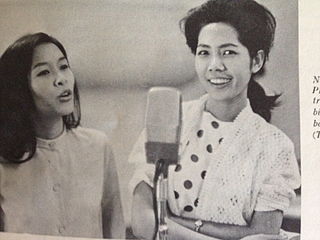
Phương Dung is a popular Vietnamese country music singer from 1960 to 1970.
Lý Thị Ngọc Kiều, dharma name Diệu Nhân (妙因), was a princess during the Lý dynasty in Vietnamese history. She was the 17th leader of the Vietnamese Vinītaruci school of Buddhism.
Trees in Chinese mythology and culture tend to range from more-or-less mythological such as the Fusang tree and the Peaches of Immortality cultivated by Xi Wangmu to mythological attributions to such well-known trees, such as the pine, the cypress, the plum and other types of prunus, the jujube, the cassia, and certain as yet unidentified trees. Mythological ideas about trees also extends to various types of fungi which lived or were thought to live underneath certain of these trees, collecting their mysterious essences.

Mai Thuc was a Vietnamese writer and journalist, who was most known for her works on Vietnam history, its people, and culture. She was the Editor-in-chief of Hanoi Women's Newspaper (1995–2003) and later in her retirement years a part-time lecturer in Hanoi Culturology at Thang Long University, Hanoi.

Chữ Hán is the term for Chinese characters in Vietnamese. Chữ Hán are used to write Literary Chinese and Sino-Vietnamese vocabulary in the Vietnamese language. They were officially used in Vietnam after the Red River Delta region was incorporated into the Han dynasty and continued to be used until the early 20th century where usage of Literary Chinese was abolished alongside the Confucian court examinations causing chữ Hán to fall into obscurity.

During the Nguyễn dynasty period (1802–1945) of Vietnamese history its Ministry of Education was reformed a number of times, in its first iteration it was called the Học Bộ, which was established during the reign of the Duy Tân Emperor (1907–1916) and took over a number of functions of the Lễ Bộ, one of the Lục Bộ. The Governor-General of French Indochina wished to introduce more education reforms, the Nguyễn court in Huế sent Cao Xuân Dục and Huỳnh Côn, the Thượng thư of the Hộ Bộ, to French Cochinchina to discuss these reforms with the French authorities. After their return the Học Bộ was established in the year Duy Tân 1 (1907) with Cao Xuân Dục being appointed to be its first Thượng thư (minister). Despite nominally being a Nguyễn dynasty institution, actual control over the ministry fell in the hands of the French Council for the Improvement of Indigenous Education in Annam.

Sacrifice to Heaven is an Asian religious practice originating in the worship of Shangdi in China. In Ancient Chinese society, nobles of all levels constructed altars for Heaven. At first, only nobles could worship Shangdi but later beliefs changed and everyone could worship Shangdi.

















